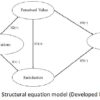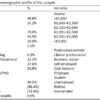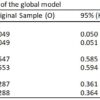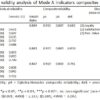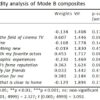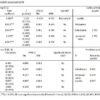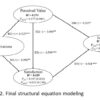ISSN 0976-0911 | E-ISSN 2249-8818
DOI: 10.15655/mw/2021/v12i2/160153
Loyalty, Motivation, and Satisfaction:
A Quantitative Analysis of the
8th Cinejoven Festival of Almería, Spain
C. García-Carballo, S. Moral-Cuadra, V. Navajas-Romero, & J.V. Fruet-Cardozo
University of Cordoba, Spain
Received: 7 January 2021| Accepted: 16 April 2021|Published: 4 May 2021
Abstract
In several cities of Spain, film festivals are regarded as prominent cultural events. The most well-known film festivals in Spain are the Valladolid International Film Week, San Sebastian, the Bilbao, Alcalá de Henares, Málaga, Manresa Almería. The Almería city, located on the Mediterranean Sea, has been striving to promote these events for a decade or so. This research aims to analyze the characteristics of the audience attending the 8th Cinejoven Film Television Festival and collaborate in the visibility of the event. Five hypotheses were tested using the variables: perceived value, motivations, and satisfaction loyalty. A sample of 207 surveys of attendees at the festival was analyzed. SmartPLS 3.2.8 software for structural equation modeling (SEM) techniques applied in this research analysis.
Keywords: Almería, cinema, festival, loyalty, motivation, perceived value, satisfaction, SEM, Spain
Introduction
In recent years, cultural events have been gaining ground as leisure activities in Spain. This type of event comprises various activities linked to art, folklore, popular religious manifestations, and the leisure entertainment. The concept is so comprehensive that it includes any activity that aims to respond to the cultural enrichment, education, novelty socialization (Araújo-Vila & Domínguez-Vila, 2012), such as viewing cave art, the remains of extinct civilizations, or routes to visit ruins, monuments, museums (Santana, 2003). According to Richard and Bonink (1995), people who leave their place of residence searching for cultural attractions aim to live new experiences that please their cultural tastes. In this regard, large cities must make a more significant effort to promote internal tourism by offering cultural events that encourage residents to attend the occasions. This suggestion would be valid, especially for Spain, since its entire geography has historical monuments, many of the world heritage sites, in an excellent state of conservation.
Cultural events are also occurring in media and communication studies. The changing cultural pattern has immensely influenced media studies, especially digital media (Pandey, 2019). Cultural events are a growing type of tourism, with an increasingly wide range of complementary peripheral products becoming more popular, attracting more significant people (Araújo-Vila & Domínguez-Vila, 2012). Culture has become an essential element as a local development strategy in urban policies to improve customs (Scott, 2000).
There has been a rise in the demand for cultural events that satisfy leisure recreation expectations (García-Sánchez & Alburquerque-García, 2012). These expectations, which are becoming increasingly frequent, seek to combine tourism with the cultural enrichment of people’s holiday needs. More specifically, there has been a shift in the interests of culture-seeking visitors to the arts that promote a range of new products, including film and television festivals. As a result, an attempt is made to establish a typology of festivals that includes this cultural leisure event.
Although the literature on film festivals is scarce, the few existing studies have shown that the primary aim of these events is to disseminate new film-makers’ work to help them consolidate their career in the film industry (Jurado-Martín, 2014). In this regard, it could be argued that film festivals occupy a specific niche in the structure of the audio-visual industry (Redondo-Neira, 2015). Moreover, these festivals, some of which are televised, have become an additional element in the cultural offering of several Spanish cities. Some of the well-known festivals are the Valladolid International Film Week (SEMINCI), the San Sebastian International Film Festival, the Bilbao International Festival of Documentary Short Films, the Alcalá de Henares Film Festival, the Málaga Film Festival and the Manresa International Noir Film Festival.
Cultural festivals saw their popularity expand, especially in recent years. They are one of the prototypes that best represent the regional cultural heritage while revitalizing the cultural offer of a region. Some Spanish cities, like Andalusia, celebrate important festivals of different artistic genres, such as those held in Seville, Malaga, and Córdoba. The purpose of these festivals is no longer only to present, spread or preserve culture, but to act as an essential alternate source of income that impacts the economic growth of the people. In other words, these events have a tourism dimension that encompasses a cultural objective and an economic one, which has attracted the attention of the scientific community. But, on this last aspect, the research on the economic impact of the events, there is still much to do.
Few studies have been conducted on the cultural festival. In this sense, this article intends to develop the academic literature on the characteristics of festival attendees using structural equation modeling (SEM). We focus on visitors’ perceptions of the 8th edition of the Almería Cinejoven Festival to analyze their behavior towards this type of cultural event and user interaction patterns in terms of motivation, perceived value, satisfaction, and loyalty. This information could help determine which models lead to higher levels of audience loyalty.
Literature Review
Williams, Soutar, Jeremy, and Naumann (2017) have studied the concept of perceived value extensively. It is generally understood concerning aspects such as the public’s attitude toward acquiring products or services (Jamal, Othman, & Muhammad, 2011). As a result of the constant evolution of viewers’ preferences motivations, the definition of perceived value has also evolved (Ramkissoon, Nunkoo, & Gursoy, 2009). From a marketing perspective, for example, perceived value is a primary parameter for knowing consumer behavior. (Kim, Ducan, & Chung, 2015). Additionally, motivation is illustrated as a set of internal and external factors that drive the public to satisfy desires (Crompton, 1979). Dann (1977) has conceptualized motivation by differentiating between two different factors: push factors, which refer to sociopsychological aspects that cause visitors to travel to specific destinations (Prayag & Hosany, 2014), and pull factors, which refer to the attributes of a particular destination (Yoon & Uysal, 2005).
On the other hand, satisfaction is defined as the cumulative experience of the public concerning multiple attributes (Pizam, Neumann, & Reichel, 1978), viewed as a psychological concept (Pizam, Shapoval, & Ellis, 2016). Satisfaction is almost associated with the notion of loyalty and is greater when the product consumed is tangible (Blackwell, Miniard, & Engel, 2001). In this regard, the concept of loyalty refers to visitors’ preference for visiting a cultural event (Pike, Bianchi, Kerr, & Patti, 2010), or the intention to recommend it to others, either through word of mouth or by expressing intentions to return to the destination, what is known as behavioural intentions (Chen & Tsai, 2007).
Motivations, Perceived Value, and Satisfaction
The effect of motivations on satisfaction has been addressed from different perspectives. Some studies have shown satisfaction to be an antecedent variable of motivation and found a significant direct relationship between both (Lee & Hsu, 2013), thus supporting the findings of Prebensen, Woo, and Uysal (2012). Similarly, Caber and Albayrak (2016) reported that satisfaction could be explained by motivational push and pull factors. In contrast, other studies have shown that satisfaction is a little motivation that means the relationship between the two is weak (Yoon & Uysal, 2005).
As regards to perceived value satisfaction, these variables are positively related given their natural affinity to the fact that both are measured directly from evaluative judgments made by the public (Woodruf & Gardial, 1996). Consequently, the perceived value construct is linked to customer satisfaction (Dorai & Varshney, 2012). Satisfaction can also be considered a direct effect of perceived value (Cronin, Brady, & Hult, 2000; El-Adly & Eid, 2016). Cronin et al. (2000) stated that motivation is an important preceding in the perceived value of specific destinations. The motives for attending festivals, such as entertainment, fun socialization, have also been studied in the respective literature (Getz & Page, 2016). In line with the above, three hypotheses are constructed:
H1: Motivations have a beneficial impact on visitor satisfaction.
H2: Motivations positively influence visitor perceived value.
H3: Visitor perceived value has a beneficial effect on subsequent attendant satisfaction.
Perceived Value, Satisfaction, and Loyalty
Satisfaction is an important precondition for visitor loyalty (Kandampully & Suhartanto, 2000). Customer gratification has been shown to have a direct beneficial impact on customer loyalty in a variety of settings (El-Adly & Eid, 2016), such as hospitality (Ryu & Parsons, 2012; Kandampully & Suhartanto, 2000), cultural events (S.-Y. Lee, Petrick, & Crompton, 2007; El-Adly & Eid, 2016), and other types of organized services (Cronin et al., 2000). Conversely, satisfaction has also been found to have an indirect influence that plays a mediating role in the relationship between customer loyalty and perceived value (Williams et al., 2017; El-Adly & Eid, 2016).
The relation between perceived value and loyalty is a notion that has not been widely analyzed in the references that concern this study. This is mainly because most people take vacations just once a year when, plausibly, they also attend cultural events such as the one examined here. Due to limited time, behavior values are not measured. However, some research has demonstrated that perceived value has a beneficial direct effect on loyalty (Cronin et al., 2000; Eid, 2015; El-Adly & Eid, 2016) while Sun, Chi, and Xu (2013), indicate that higher perceived value does not necessarily imply increased public loyalty. Because of the above, two hypotheses are proposed:
H4: Visitors’ perceived value of a destination has a beneficial effect on their loyalty to the goal.
H5: Satisfaction has a beneficial effect on visitor loyalty.
Methodology
The study population comprised visitors to the 8th Cinejoven Film Television Festival held in Almeria, Spain, from 3 to 8 December 2018. According to the organization’s website (http://CineJoven.es/), in previous editions, more than nineteen thousand people attended the exhibitions, talks, conferences on the seventh art. However, as per the information provided by the organizers, about two thousand visitors attended the 8th edition of the festival. The survey method used in this research is based on the works of Yolal, Woo, Cetinel, and Uysal (2012) and was carried out by a team of pollsters linked to the University of Córdoba. They were filled in different places where the films were held. A non-probabilistic sampling was used in this research where the sample is available to be surveyed in a given location and time (Finn, Elliot-White, & Walton, 2000). The total of surveys carried out was 215. After ruling out invalid surveys, the final sample was 207, with a sampling error of 3.9%. The survey was conducted in Spanish and English languages.
The questionnaire was developed based on prior research that employed items composites from previous studies conducted by researchers in the field, thereby ensuring its validity. The survey was structured in three sections. The first contained items related to motivations for visiting the event; the second section addressed aspects such as satisfaction, perceived value, and loyalty to the event; finally, the last one asked respondents to provide sociodemographic information. The first two sections were measured using 5-point Likert scales, while the third contained open-ended questions. The survey was anonymous, and the festival support staff from the University of Córdoba were available to clarify doubts and answer the questions.
The data were tabulated using the SPSS v. 24 software package to determine the surveyed’ sociodemographic profiles (Table 1). Cronbach’s alpha was used for the reliability analysis, obtaining a final overall value of 0.985, which is significantly above the lower limit of 0.7 indicated by Nunnally (1994).
After evaluating the global and measurement models, the SmartPLS 3.2.8 program was used to analyze the data and test the path coefficients’ statistical inference (see Figure 1). According to Chin (2010), models can be estimated using composite measures or indicators that are reflective or formative (Mode A and Mode B, respectively), which does not lead to model identification problems.
Results
Sociodemographic Profile
Table 1 shows that a little majority of the surveyed were female (51.2%), and more than half were aged 21–40. Likewise, more than a third had a university education (37.6%), closely followed by those with a high school (32.2%). In terms of professional activity, most were students (33.8%), followed by employees (18.2%), and civil servants (11.6%). The majority were Spanish (99.5%), with 86.4% from the region of Andalusia. Regarding income level, half of the surveyed population stated that they earn a monthly income of a little more than €1,000 (51.1%), followed by those who earned between €1,000 and €1,500 (21%). Only 6.5% stated that they earned more than €3,000.
Assessment of the Global Model
Given the affirmative approach of this research, we analyzed the model’s goodness-of-fit indicators. For this purpose, exact bootstrapping tests were used (Dijkstra & Henseler, 2015). In this context, Henseler (2017) established three accurate bootstrapped-based goodness-of-fit indices for estimated models (see SRMR, d_ULS, d_G), whose values must be below the reference levels (HI95/HI99). The indices are shown in Table 2.
Assessment of the Measurement Model
Regarding the measurement model, a validity analysis was performed of the Mode A composites (perceived value, satisfaction loyalty) the Mode B composites (motivations). For Mode A, factor loadings analysis was performed to determine the reliability of the items in each of the composites. The loadings must be equal to or greater than 0.707 (Carmines & Zeller, 1979).
Composite reliability, or internal consistency analysis, is used to determine how rigorously the observable variables measure the same composite. For this purpose, a study was performed using Cronbach’s alpha (≥ 0.7), Rho_C (≥ 0.7), Rho_A (≥ 0.7), and convergent validity by the average variance extracted (AVE ≥ 0.5) (Dijkstra & Henseler, 2015). All the analysis results exceeded the lower threshold, indicating that the composite reliability or internal consistency was optimal.
For the analysis of the Mode A composites, discriminant validity was performed to determine the extent to which the composites were different from one another. The heterotrait-monotrait (HTMT) ratio was used to this end, being the best measure for detecting lack of discriminant validity (Henseler, Ringle, & Sarstedt, 2015). HTMT ratio values must be lower than 0.85 (Kline, 2016). The results for the individual reliability, internal consistency discriminant validity of the Mode A composites are shown in Table 3.
The Mode B composites were analyzed to identify any multi-collinearity problems in the significance of the loadings. Multi-collinearity refers to the linear inter-correlations between two or more formative indicators, leading to unstable estimates (Chin, 2010). The variance inflation factor (VIF) test indicates which values greater than 3.3 (VIF > 3.3) would cause multi-collinearity problems (Roberts & Thatcher, 2009). The results indicated that there were no multi-collinearity problems in the model.
The structure of each Mode B composite was obtained by the loadings, which show the relative importance of each indicator comprising the construct. To determine the significance of the weights, a bootstrapping test was performed. According to Hair, Hult, Ringle, and Sarstedt, 2017), when the weight of an indicator is non-significant, the outer loading is below 0.5, it should be eliminated. Therefore, indicator Q6.5 was eliminated. Table 4 shows the results of the analysis for the Mode B composites.
Assessment of the Structural Equation Modeling
The structural model was assessed by analyzing the possible multi-collinearity between the structural model composites, hypothesis contrast, the coefficient of determination (R2) by variance decomposition of the effect sizes (f2).
According to Hair et al. (2017), multicollinearity problems could not exist between constructs if the VIF value is less than 5, a condition that is satisfied, as shown in Table 5 (5.2).
The path coefficients represent an estimate of the relationships between the constructs of the structural model. Therefore, to test the hypotheses proposed in the model, bootstrapping was performed with five thousand samples to determine the significance of the impact to obtain the standard error and statistical confidence intervals. Given that the model data showed a non-normality distribution, testing was performed using the confidence intervals. Regarding the confidence intervals, Henseler, Ringle, and Sinkovics (2009) highlighted that “if a confidence interval for an estimated path coefficient pci does not include the value zero, then the hypothesis that pci is equal to zero is rejected.” In this study, hypotheses were tested using t-statistics confidence intervals Table 5 (5.1).
The tests revealed the model’s predictive power, with the following coefficient of determination levels (R2): R2SATISFACTION = 0.429; R2PERCEIVEDVALUE = 0.274, R2LOYALTY = 0.507. In this context, Falk and Miller (1992) stated that R2 values of 0.10 are substantial, while Chin (1998) has described R2 values of 0.67 as considerable, 0.33 as modest, 0.19 as weak.
As per this approach, our study satisfaction loyalty showed moderate R2, and values perceived value showed weak R2 values (Table 5 (5.3)). The explained variance is significant in the coefficient of determination. Perceived value explains 39.93% of the variance for satisfaction; while satisfaction explains 39.98% of the variance for loyalty. Additionally, motivations explain 27.4% and 3.93% of the variability of the perceived value satisfaction, respectively (see Table 5 (5.3)).
According to Cohen (1988), effect size (f2) measures how much an exogenous parameter describes a given endogenous parameter in terms of R2. The author suggested that f2 values of 0.02–0.15 show a little result; 0.15–0.35 a moderate effect, and values greater than 0.35 a large effect. In this study, f2 values were found to be significant for Motivation → Perceived value (f2 = 0.377; p = 0.001); Satisfaction → Loyalty (f2 = 0.369; p = 0.049), and Perceived value → Satisfaction (f2 = 0.457; p = 0.003). The final graph of the structural equation modeling designed is presented in Figure 2.
Conclusion
The results show a fragile hence non-significant relationship between visitor motivation satisfaction. This conclusion agrees with the preceding research (Yoon & Uysal, 2005), supporting our work. Moreover, we found that motivations impact favourably on perceived value following other authors (Getz & Page, 2016) who have also highlighted this effect. This study has also shown the favorable effect of moviegoer satisfaction on loyalty in line with previously conducted studies (Kandampully & Suhartanto, 2000). The direct positive role that perceived value plays in visitor loyalty has also been proven, again as evidenced by preceding research (Cronin et al., 2000; Eid, 2015; & El-Adly & Eid, 2016). El-Adly and Eid (2016) studied the positive influence of perceived value on satisfaction. Studies on cultural festivals, carried out by Gomez-Casero, Moral-Cuadra, Jara-Alba, and Pérez-Gálvez (2018) have also shown this influence which is in line with the results obtained in this research.
The results confirm the five hypotheses considered in the study. Thus, in the general evaluation of the model, bootstrapping tests were carried out. They estimate the probability of inconsistencies between the correlation matrices included in the model. The empirical correlation matrix determined three detailed goodness-of-fit indices. Likewise, the evaluation of the measurement model showed that the accuracy validity of the Mode A composites (perceived value, satisfaction, and loyalty) satisfactorily overcame the level of 0.707 recommended by Carmines and Zeller (1979), therefore can be considered positive. The reliability validity analysis for the Mode B composites yielded similar results. Hence, it can be concluded that the 8th Cinejoven Festival has a more than satisfactory level of visitor loyalty.
The main feasible utilization of this study is to contribute to the research of the attributes of moviegoers who visit film cultural festivals to develop offers more appropriate products that satisfy their cultural needs. Based on the analysis, we have identified three critical implications for the Cinejoven festival management. In the first place, the need for more significant promotion of the event to increase its undoubted cultural essence is evident. In this context, it would first be necessary to start in the rest of Spain and later in neighboring countries, such as France, Portugal, and Italy. Secondly, in our opinion, the public that attended the 8th edition of the Festival was looking for new cinematographic experiences. Therefore, without giving up its cultural essence, the organizers should consider other film genres in the program, such as Westerns, thrillers, action films, etc. Third, to enhance the image of the festival as a cultural event, a broader range of complementary services should be provided at film exhibition venues, such as cafeterias, bars, vending machines, among others. Besides, it is also vital to improve the visibility of the information points of the place and the signage for visitors.
This study may give rise to future studies that could be oriented to achieve similar analyses of other cultural festivals to identify the common and differentiating aspects between them. Another specific and urgent line of the study refers to researching the economic impact of these events in the cities where they are organized. These investigations would contribute to the development of cultural management as an academic discipline in Andalusia and the rest of Spain.
Acknowledgments: The authors would like to mention and thank the support of the Organizing Committee of the 8th Almería Film and Television Festival for having made possible the task of preparing visitor surveys.
Declaration of conflicting interests: The author(s) declared no potential conflicts of interest concerning the research, authorship, and/or publication of this article.
Funding: The author(s) received no financial support for the research, authorship, and/or publication of this article.
Notes
1Q11.1: The festival content is interesting. Q11.2: The festival program is diverse and varied. Q11.3: It is easy to find information, including the program and content. Q11.4: The program is entertaining. Q11.5: The festival organizers provided detailed information.
2Q12.1: I made a good choice by coming to the festival. Q12.2: My level of satisfaction with the festival is high. Q12.3: My overall evaluation of the festival is positive.
3Q13.1: If someone asked me, I would recommend coming to the festival. Q13.2: I would encourage my family and friends to come to the festival. Q13.3: After this experience, I would come again in the future.
References
Araújo-Vila, N., & Domínguez-Vila, T. (2012). Los festivales de cine como elemento potenciador de destinos turísticos. El caso de San Sebastián. Revista de Comunicación VivatAcademia(121), 31 – 49. doi:10.15178/va.2012.121.31-49
Blackwell, R., Miniard, P., & Engel, J. (2001). Consumer behaviour. In. Orlando, FL, USA: Harcout College Publishers.
Caber, M., & Albayrak, T. (2016). Push or pull? Identifying rock climbing tourists’ motivations. Tourism Management, 55, 74 – 84. doi:10.1016/j.tourman.2016.02.003
Carmines, E., & Zeller, R. (1979). Reliability and validity assessment (Vol. 1). Beverly Hills, CA, USA: Sage University.
Chen, C.-F., & Tsai, D. C. (2007). How destination image and evaluative factors affect behavioral intentions? Tourism Management, 28, 1115 – 1122. doi:10.1016/j.tourman.2006.07.007
Chin, W. (1998). The partial least squares approach to structural equation modeling. In T. F. Group (Ed.), Modern Methods for Business Research (Vol. 1, pp. 295 – 336). Mahwah, N.J., USA: Psychology Press.
Chin, W. (2010). How to write up and report PLS analyses. In S. Link (Ed.), Springer Handbooks of Computational Statistics (pp. 655-690). Berlin, Heidelberg, Germany: Handbook of Partial Least Squares. Esposito Vinzi, W. W. Chin, J. Henseler, & H. Wang (Eds.).
Cohen, J. (1988). Statistical power analysis for the behavioural sciences (2nd ed.). New York, USA: Routledge.
Crompton, J. L. (1979). Motivations for pleasure vacation. Annals of Tourism Research, 6(4), 408-424. doi:10.1016/0160-7383(79)90004-5
Cronin, J., Brady, M., & Hult, G. (2000). Assessing the effects of quality, value, and customer satisfaction on consumer behavioral intentions in service environments. Journal of Retailing, 76(2), 193-218. doi:10.1016/S0022-4359(00)00028-2
Dann, G. (1977). Anomie, Ego-enhancement, and Tourism. Annals of Tourism Research, IV(4), 184 – 194. doi:10.1016/0160-7383(77)90037-8
Dijkstra, T., & Henseler, J. (2015). Consistent Partial Least Square Path Modeling. In (Vol. 39, pp. 297-316). Netherland: MIS Quaterly.
Dorai, S., & Varshney, S. (2012). A multistage behavioural and temporal analysis of CPV in RM. Journal of Business & Industrial Marketing, 27(5), 403 – 411. doi:10.1108/08858621211236070
Eid, R. (2015). Integrating Muslim Customer Perceived Value, Satisfaction, Loyalty and Retention in the Tourism Industry: An empirical study. International Journal of Tourism Research, 17(3), 249-260. doi:10.1002/jtr.1982
El-Adly, M., & Eid, R. (2016). An empirical study of the relationship between shopping environment, customer perceived value, satisfaction, and loyalty in the UAE malls context. Journal of Retailing and Consumer Services, 31, 217 – 227. doi:10.1016/j.jretconser.2016.04.002
Falk, R., & Miller, N. (1992). A primer for soft modelling (A. PsycNet Ed.). Akron, OH, USA: University of Akron Press.
Finn, M., Elliot-White, M., & Walton, M. (2000). Tourism and Leisure Research Methods: Data Collection, Analysis, and Interpretation (Vol. 1). Harlow, London, UK: Pearson Education.
García-Sánchez, A., & Alburquerque-García, F. (2012). El turismo cultural y el de sol y playa: ¿sustitutivos o complementarios? In (Vol. 11, pp. 97 – 105): Cuadernos de Turismo.
Getz, D., & Page, S. (2016). Event Studies. Theory, research, and policy for planned events (3rd ed. Vol. 1). London, UK: Routledge – Taylor & Francis Group.
Gomez-Casero, G., Moral-Cuadra, S., Jara-Alba, C., & Pérez-Gálvez, J. (2018). Motivación y lealtad turística: un modelo estructural para las artes escénicas. El Festival Internacional de Teatro Clásico de Almagro, España. Espacios, 39(26), 30-47.
Hair, J., Hult, G., Ringle, C., & Sarstedt, M. (2017). A primer on partial least squares structural equation modeling (PLS-SEM). Thousand Oak, CA, USA: Sage Publishing.
Henseler, J. (2017). Bridging design and behavioral research with variance-based structural equation modeling. Journal of Advertising, 46(1), 178-192. doi:10.1080/00913367.2017.1281780
Henseler, J., Ringle, C., & Sarstedt, M. (2015). A new criterion for assessing discriminant validity in variance-based structural equation modeling. Journal of the Academy Marketing Science, 43, 115-135. doi:10.1007/s11747-014-0403-8
Henseler, J., Ringle, C., & Sinkovics, R. (2009). The use of partial least squares path modeling in international marketing. Advances in International Marketing, 20, 277-319. doi:10.1108/S1474-7979(2009)0000020014
Jamal, S., Othman, N., & Muhammad, N. (2011). Tourist perceived value in a community-based homestay visit: An investigation into the functional and experiential aspect of value. Journal of Vacation Marketing, 17(1), 5 – 15. doi:10.1177/1356766710391130
Jurado-Martín, M. (2014). Nuevas propuestas, viejos circuitos. El papel de los festivales de cine españoles en la consolidación de los nuevos realizadores., 39, 100 – 122.
Kandampully , J., & Suhartanto, D. (2000). Customer loyalty in the hotel industry: the role of customer satisfaction and image. International Journal of Contemporary Hospitality management, 12(6), 346-351. doi:10.1108/09596110010342559
Kandampully, J., & Suhartanto, D. (2000). Customer loyalty in the hotel industry: the role of customer satisfaction and image. International Journal of Contemporary Hospitality management, 12(6), 346-351. doi:10.1108/09596110010342559
Kim, Y. H., Ducan, J., & Chung, B. W. (2015). Involvement, satisfaction, perceived value, and revisit intention: a case study of a food festival. Journal of Culinary Science & Technology, 15(2), 133-158. doi:10.1080/15428052.2014.952482
Kline, R. (2016). Principles and practice of structural equation modelling (4th ed. Vol. 1). New York, USA: The Guilford Press.
Lee, S.-Y., Petrick, J., & Crompton, J. (2007). The roles of quality and intermediary constructs in determining festival attendees’ behavioral intention. Journal of Travel Research, 45(4), 402 – 412. doi:10.1177/0047287507299566
Lee, T. H., & Hsu, F. Y. (2013). Examining how attending motivation and satisfaction affects the loyalty for attendees at aboriginal festivals. In (Vol. 15, pp. 18-34): International Journal of Tourism Research.
Nunnally, J., & Bernstein, I. (1994). Psychometric Theory. In. New York, USA: McGraw-Hill.
Pike, S., Bianchi, C., Kerr, G., & Patti, C. (2010). Consumer-based brand equity for Australia as a long-haul tourism destination in an emerging market. In (Vol. 27, pp. 434-449): International Marketing Review.
Pizam, A., Neumann, Y., & Reichel, A. (1978). Dimentions of tourist satisfaction with a destination area. Annals of Tourism Research, 5(3), 314 – 322. doi:10.1016/0160-7383(78)90115-9
Pizam, A., Shapoval, V., & Ellis, T. (2016). Customer satisfaction and its measurement in hospitality enterprises: a revisit and update. International Journal of Contemporary Hospitality Management, 28(1), 2-35. doi:10.1108/IJCHM-04-2015-0167
Prayag, G., & Hosany, S. (2014). When Middle East meets West: Understanding the motives and perceptions of Young tourists from United Arab Emirates. Tourism Management, 40, 35-45. doi:10.1016/j.tourman.2013.05.003
Prebensen, N. K., Woo, E., & Uysal, M. A. (2012). Motivation and involvement as antecedents of the perceived value of the destination experience. Journal of Travel Research, 52(2), 253-264. doi:10.1177/0047287512461181
Ramkissoon, H., Nunkoo, R., & Gursoy, D. (2009). How consuption values affect destination image formation. Advances in Culture, Tourism and Hospitality Research, 3, 143 – 168. doi:10.1108/S1871-3173(2009)0000003008
Redondo-Neira, F. (2015). Festivales de cine y tendencia de futuro. Un estudio de caso. Opción, 31(1 (Especial)), 620 – 633.
Richard, G., & Bonink, C. (1995). European Cultural Tourism Markets. In (Vol. 1, pp. 173 – 180): Journal of Vacation Marketing.
Roberts, N., & Thatcher, J. (2009). Conceptualizing and testing formative constructs: Tutorial and annotated example. ACM SIGMIS Database, 40(3), 3 – 39. doi:10.1145/1592401.1592405
Ryu, H., & Parsons, D. (2012). Risky business or sharing the load? – Social flow in collaborative mobile learning. Computers & Education, 58(2), 707 – 720. doi:10.1016/j.compedu.2011.09.019
Santana, A. (2003). Turismo cultural, culturas turísticas. Horizontes antropológicos, 9(20), 1 – 12. doi:10.1590/S0104-71832003000200003
Scott, A. (2000). The cultural economy of cities. London, UK: Sage Publishing.
Sun, X., Chi, C. G., & Xu, H. (2013). Developing destination loyalty: the case of Hainan Island. Annals of Tourism Research, 43, 547-577. doi:10.1016/j.annals.2013.04.006
Pandey, U. S. (2019). The Digital Turn in Media and Communication Studies.Media Watch, 10(2).
Williams, P., Soutar, G., Jeremy, N., & Naumann, A. (2017). Value drivers and adventure tourism: A comparative analysis of Japanese and Western consumers. Journal of Service Theory and Practice, 27(1), 102 – 122. doi:10.1108/JSTP-05-2015-0116
Woodruf, R., & Gardial, S. (1996). Know your customer: New approaches to customer value and satisfaction. In. Cambridge, MA, USA: Blackwell.
Yolal, M., Woo, E., Cetinel, F., & Uysal, M. (2012). Comparative research of motivations across different festival products. International Journal of Event and Festival Management, 3(1), 66 – 80. doi:10.1108/17582951211210942
Yoon, Y., & Uysal, M. (2005). An examination of the effects of motivation and satisfaction on destination loyalty: A structural model. Tourism Management, 26(1), 45-56. doi:10.1016/j.tourman.2003.08.016
García Carballo, Carlos (Ph.D., University at the of Malaga, 2015) is an Associate Professor in the Department of Business Administration at the University of Cordoba, Spain. His research focuses on cinematography, advertising and audiovisual communication.
Moral-Cuadra, Salvador (Ph.D., University of Cordoba, 2017) is a Lecturer in the Department of Financial and Accounting at the University of Granada, Spain. His current research interests are primarily in the areas of economy of tourism and culture.
Navajas Romero, Virginia (Ph.D., University of Cordoba, 2014) is a Lecturer in the Department of Business Administration at the University of Cordoba, Spain. Her research interests lie in tourism economy.
Fruet-Cardozo, J. Vicente (Ph.D., University of Cordoba, 2006) is a senior Lecturer in the Department of Applied Economics at the University of Cordoba, Spain. His research focuses on economy of culture and tourism and financial economics.
This article is distributed under the terms of the Creative Commons Attribution 4.0 License (https://creativecommons.org/licenses/by/4.0/), which permits any use, reproduction and distribution of the work without further permission provided the original work is attributed properly. The article may be reused without special permission provided that the original article is properly attributed. Reuse of an article does not imply prior approval by the authors or Media Watch.
